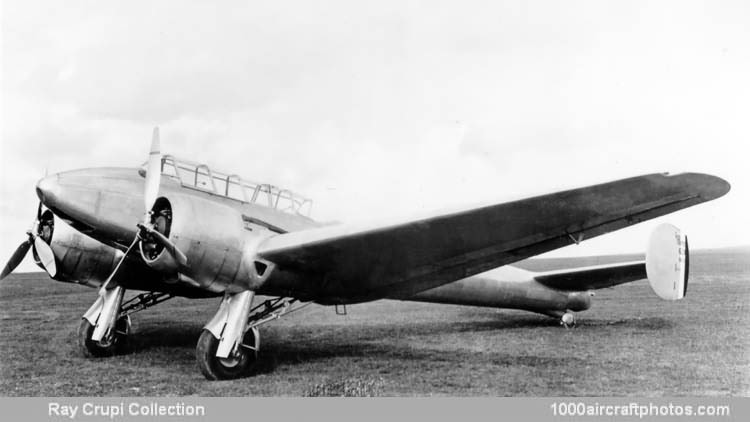08/31/2010. Remarks by Johan Visschedijk: "There can be no denying that the strategic fighter concept was far-sighted, but it is equally undeniable that its fulfillment was extremely difficult. No more arduous a task could have been set a combat aircraft designer than that of evolving a long-range multi-seat fighter capable of escorting bombers, deep penetrations of enemy territory, standing patrols and, for good measure, day and night interception.
The desired range could only be obtained at the expense of maneuverability, and maneuverability was a vital quality if the strategic fighter was to combat effectively the more specialized defensive fighter by which it would be opposed. Such an aircraft had to be a compromise, and compromises are rarely good enough. Certainly no entirely satisfactory strategic fighter emerged from the 'thirties, but at the time of its debut in 1936, the Potez 63 appeared to come as close to fulfilling strategic fighter requirements as any aircraft conceived at that time.
The Potez 63 was widely considered to be a trend setter, and some Frenchmen were subsequently to claim that it provided the inspiration for the Messerschmitt Bf 110. It is true that both French and German aircraft were slim, rakish, twin-engined low-wing cantilever monoplanes of all-metal, flush-riveted, stressed-skin construction, with retractable landing gears and twin fins and rudders, but the claim had no foundation in fact as design development of both Potez 63 and Bf 110 had begun virtually simultaneously at Méaulte and Augsburg respectively, the prototypes making their initial flights within 18 days of each other.
The Potez 63 was designed by Louis Coroller and André Delaruelle to meet the requirements of a specification issued in October 1934 by the Service Technique de l'Aéronautique which called for a C3 (Triplace de Chasse or Three-seat Fighter) aircraft, and competed for orders with the Hamiot 220, the Loire-Nieuport 20, the Romano 110, and the Breguet 690.
The specification called for a twin-engined aircraft designed around the new Hispano-Suiza and Gnome & Rhône air-cooled radial engines of small diameter. Fixed forward-firing armament had to include a 0.787 in (20 mm) cannon, and sufficient radio equipment had to be carried to enable the aircraft to act as controller for single-seat fighter formations.
Work on the Potez 63 No. 01 began at Méaulte, Picardie, France in April 1935, and almost exactly one year later, on April 25, 1936, the prototype was flown for the first time. For initial trials, the Potez 63 No. 01 was fitted with a provisional braced wooden tail assembly suitable for the testing of fins and rudders of various shapes and sizes, and flight testing proceeded satisfactorily until May 6th when the port engine shed an airscrew blade. The engine promptly tore itself from its mount and hung suspended beneath the wing from two flexible connections. The pilot, André Nicolle, succeeded in retaining control, eventually managing to jettison the dead engine and land without further damaging the aircraft.
After repairs, flight testing was resumed at Méaulte and, on August 3, 1936, the aircraft was ferried to Villacoublay, returning to Méaulte four weeks later to receive its definitive metal tail assembly. Simultaneously, a new landing gear with longer-stroke shock-absorber struts was fitted, the aircraft returning to Villacoublay on November 20, and commencing its official CEMA (Centre d'Essais du Materiel Aerien) trials during the following month. These were suspended briefly during January 1937 to enable modifications to be made to the 580 hp Hispano-Suiza 14Hbs engines, the landing gear and the tail assembly, but were completed during the early spring, revealing only minor defects, such as the need to improve control balance and low-speed longitudinal stability.
The original C3 requirement had specified the Hispano-Suiza 14 and the Gnome & Rhône 14 Mars as alternative power plants, and, accordingly, a second prototype fitted with the latter engine had been built, and had flown at Méaulte on March 15, 1937 with test pilot Georges Détré at the controls. This received the designation Potez 631 C3 No. 01 and thus the Hispano-Suiza-engined prototype became the Potez 630 C3 No. 01.
In May 1937, by which time Coroller and Delaruelle had presented proposals for several derivatives of the basic Potez 63 design, a contract was received from the Ministere de l'Air calling for 10 prototype and evaluation aircraft which were to include those already flying. This contract comprised four Potez 630s (three three-seat fighters and one two-seat night fighter), three Potez 631s (two three-seat fighters and one dual-control conversion trainer), one Potez 633 two-seat light bomber, one Potez 637 three-seat army co-operation and reconnaissance aircraft, and one Potez 639 two-seat attack bomber. Simultaneously, preparations for the series production of the Potez 63 were initiated at Méaulte.
In the following month the Méaulte facilities, together with those of the CAMS (Chantiers Aéro-Maritimes de la Seine) and Mureaux concerns, and part of those of the Amiot and Breguet companies, were nationalised as the Societe Nationale de Constructions Aéronautiques du Nord (SNCAN). A total of 1,395 aircraft were produced, of which 1,115 went to the French AF."
